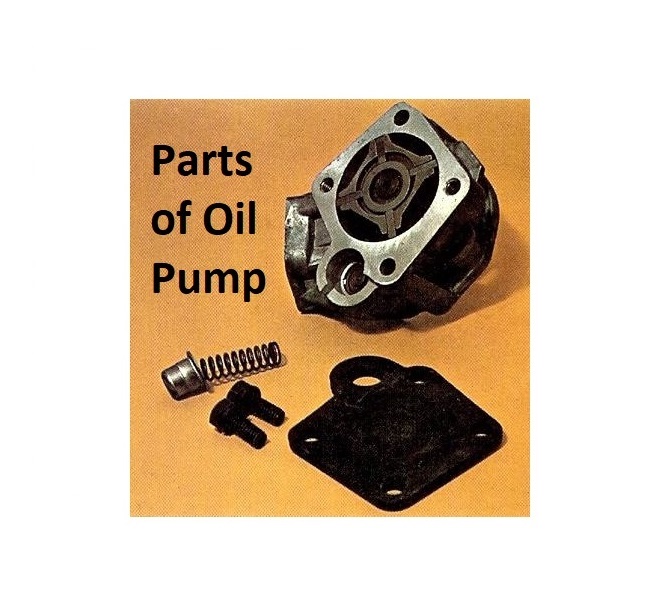Parts of Oil Pump – The Oil Pump, which is part of the lubrication system, delivers oil under pressure to the moving elements of your engine, such as the bearings, pistons, and camshaft. It generates pressure by drawing oil from the engine using gears and crankshafts. In an internal combustion engine, the oil pump is placed inside the oil pan at the bottom of the engine. In this post, we’ll look at the parts of oil pump.
⇒ View a Comprehensive List of Pumps for Sale and Their Suppliers ⇐
Oil Pump Definition
Oil pump is responsible for oil circulation in an internal combustion engine. Oil pump is a pressure-pump component of an engine’s lubricating system. It circulates oil from the sump to the revolving bearing, sliding pistons, and camshaft of the engine through the galleries.
The system’s principal goal is to circulate pressurized fluid lubricating oil throughout the engine’s moving components. The engine’s temperature is likewise maintained by the pumped oil.
The rotary and gear oil pumps are the two types of oil pumps. Both of these pumps are built to provide more oil than is typically necessary for lubrication. The oil pressure is limited by a spring-loaded pressure relief valve. At normal oil pressure levels, the spring keeps the pressure relief valve closed, and during high oil pressure conditions, it opens. If your car’s oil pump isn’t working correctly, it has to be replaced as soon as possible.
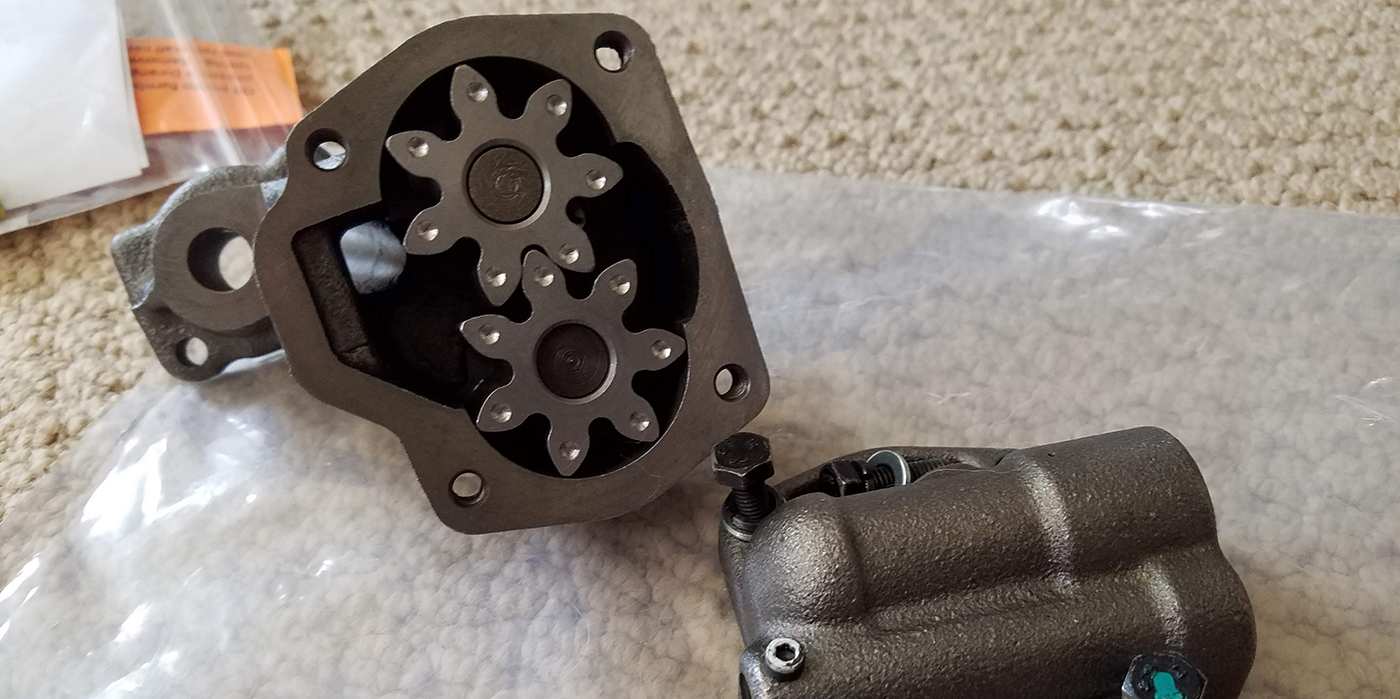
The oil pump is a mechanical mechanism that circulates oil to moving elements of an engine, such as bearings, camshafts, and pistons, to prevent wear and tear. It is one of the most important components of an engine’s lubrication system that must not fail or malfunction, or else the engine would break down.
An oil pump in a car performs the following functions:
- Under pressure, oil is transferred to the engine’s essential components.
- The movement of engine lubricant around the engine is made easier.
- Provides direction for the oil’s passage through the galleries and to various areas.
- Aids in the return of heated oil to the reservoir’s cooler oil.
- Maintains constant oil circulation within the engine.
An engine’s oil pump is unavoidable for lubrication, as engines must be adequately lubricated while operating. The oil pump is normally powered by gear from the crankshaft and begins pumping oil as soon as the engine is started. Oil injectors are not used in some oil-free engines, such as two-stroke engines.
Oil travels from a strainer into the oil pump, then via the heat exchanger, where it is cooled. After cooling, the oil passes via the galleries to the engine’s moving components before returning to the sump. A little amount of oil is transferred to an injector when an engine is designed so.
The gap between the cylinder wall and the piston rings is sealed by oil poured into the cylinder. This keeps the compressed air from escaping through the pistons, increasing the engine’s overall efficiency.
Oil pressure in an engine may reach 10 psi for every 1000 revolutions per minute (rpm), which is around 55-65 psi. The pressure on the crankshaft journal and bearing is substantially higher than the 50-60 psi established by the relief valve on the relative pump and can reach hundreds of psi.
The relative speeds of the crankshaft journal in feet per second, not rpm, cause this tremendous pressure. The bearing, bearing width, oil viscosity, and temperature are all taken into account, as well as the bearing clearance (leakage rate).
Low-speed engines have relatively big journals, as well as a small pump and pressure. This is because pump pressure does not fill the hole and replenish the oil in the annular area as quickly as the leak occurs.
Low pressure means that bearing leakage is greater than the pump’s supply rate. For more information about the working principle of oil pumps, click on this link.
Main Parts of Oil Pump Based on the Type
If seizure or excessive wear is to be avoided, several highly stressed, quickly moving components of a modern internal-combustion engine require regular lubrication. An oil pump’s job is to deliver oil under pressure to those sections of the engine that require it. The oil pump is one of the most vital engine ancillaries, and we don’t have to tell you that.
An engine’s dependability is primarily dependent on effective lubrication, and the oil pump is at the core of the lubrication system. If the oil pump breaks, a catastrophic mechanical failure will occur fast. The oil pump must propel oil from the sump into the lubrication system at a high enough pressure to reach all of the bearings and contact points.
The oil pump must, above all, be dependable and long-lasting, which is why they are relatively basic systems with few moving parts and low or no maintenance requirements. Oil pumps can be found on either the inside or outside of the engine; when positioned within the crankcase, maintenance is only possible during large engine overhauls.
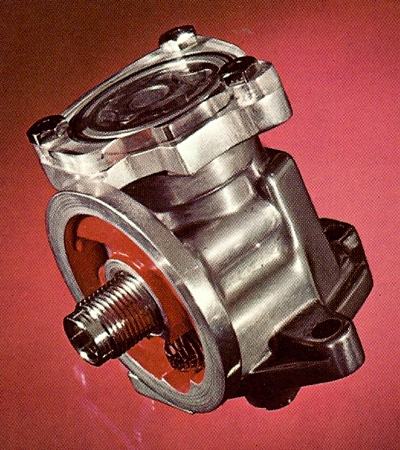
There are three main types of oil pumps in frequent usage, as well as various mounting and driveways. The oil pump, on the other hand, is generally located between the sump and the oil filter, low on the engine block, in all systems. Since we want to introduce the parts of the oil pump in this post completely, we should provide the different types of them and introduce the parts of each type.
The Gear
The gear kind of oil pump was formerly the most frequent. It was made up of two meshing gears that rotated within a tight-fitting casing. The gears transported oil around the housing as they spun. The oil was driven into the pump by the gear teeth meshing. This gear-type oil pump delivered a steady stream of oil to the engine’s numerous components. If the flow is impeded, the oil pressure might build-up to the point where the pump is damaged.
If the engine oil was unusually thick, the pressure necessary to move the cold oil through the narrow bearing clearances may generate a similar pressure build-up, potentially destroying the pump. An oil pressure relief valve was installed to eliminate these possibilities. When the pressure developed surpassed a specified value, this returned oil to the sump, or the oil tank if a dry-sump system was utilized.
The Rotor
The rotor oil pump is a type of oil pump that is more popular than the gear type. A rotor with four or five exterior lobes rotates inside an outer ring (referred to as a stator) with five or six interior lobes. The inner rotor’s axis was displaced from the outer ring’s axis. The result was that, although the inner rotor drove the outer ring, the volume between the lobes changed as the two revolved.
As a result, oil became trapped between the lobes and was driven out of the pump discharge tube. In some aspects, the functioning of this type of oil pump is similar to that of a Wankel or rotary engine. A pressure relief valve was also required for the rotor-type oil pump.
Eccentric Rotor
The eccentric rotor type of oil pump, which was invented by Hobourn Eaton, is the most frequent kind in current automobiles. An exterior and internal rotor, placed eccentrically in respect to each other, are the essential components. Each rotor contains many lobes, with the inner rotor having four positioned on the exterior face and the outer rotor having five facing inwards.
Although the exact arrangement varies from pump to pump, the outer rotor always has one more lobe than the inner rotor. The crescent-shaped intake and exit ports are the most essential elements of both rotors, which are placed within the pump body. The inner rotor is rotated by a drive from the camshaft, which then turns the outer rotor. Through the intake port, oil is sucked in and trapped between the opposing lobes.
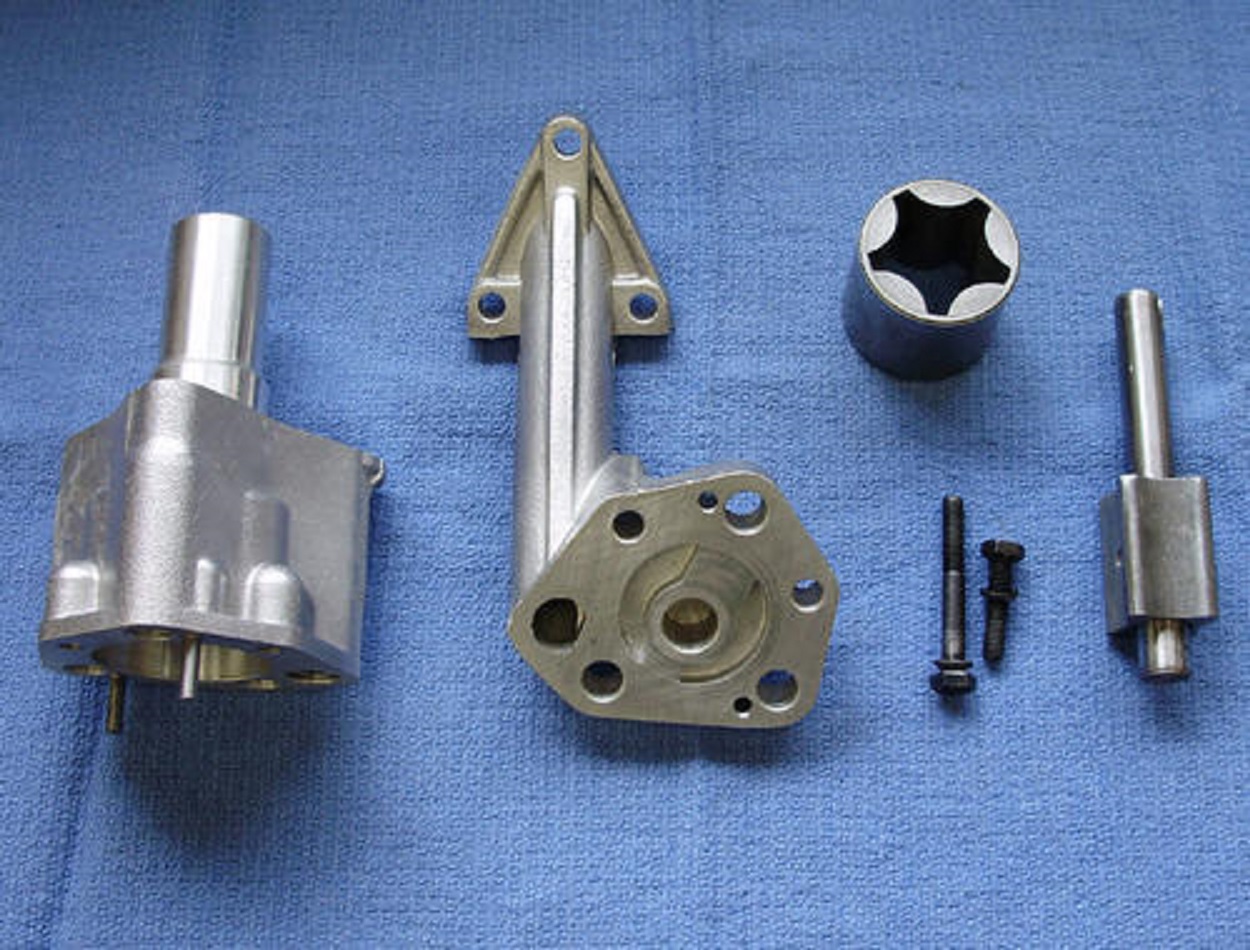
The clearance between the lobes reduces as the outer rotor rotates faster, and pressure builds until the output port is exposed. Oil is pumped under pressure into the lubricating system when the edge of the rotor passes the exit port. The procedure is repeated in each area generated by the lobes, resulting in a continuous flow of oil.
The eccentric rotor pump is the most efficient of all oil pump types, and it is used by practically all major manufacturers. It usually lasts a long time, although wear between the rotors ultimately causes greater clearances. When the maximum clearance is exceeded (usually around,006in), both rotors must be replaced as a pair. Wear can also occur on the peaks in the pump body, necessitating the purchase of a new pump.
The Rotary-Plunger
The rotary-plunger oil pump is a less frequent form of the oil pump. A worm gear revolved around a rotary plunger, which is the only moving element. The reciprocating movement was provided by a peg engaging a profiled groove in the rotary plunger, resulting in the pumping motion.
It was also essential to install a non-return valve. This type of oil pump’s oil flow was irregular, and the pressure it generated was often lower than that of gear or rotor-type oil pumps. As a result, it was fundamentally unsuited for many engines. However, it was employed in some engines that used roller or ball races as big-end or main bearings, requiring relatively minimum lubrication.
An eccentric peg on the end of a shaft, which contacted a slot in the plunger, was used to reciprocate a plunger oil pump in rare cases. Oil could leak back through the system to the sump when the engine was stopped, which was a specific drawback of both the gear and rotor-type oil pumps. As a result, neither of them was totally ideal for a dry-sump lubrication system that would instead use a plunger pump.
The Sliding-Vane
A rotor positioned eccentrically in a bore machined in the pump body makes up the sliding vane pump. A number of sliding vanes, usually four, are carried by this rotor. Each vane is housed in a groove, and contact compels the vanes to retract due to the rotor’s eccentric setting. Because the vane’s outside edge maintains contact with the pump body, the pump is always split into three chambers with varying volumes.
Oil is sucked into the area as the vanes pass through the input port, and as the chamber shrinks, the trapped oil gets pressured. As a result, as the vanes pass through the outlet port, oil is propelled under pressure into the engine. This type of pump is very efficient and has a low leakage rate, but it is prone to wear due to the huge number of moving components.
The majority of modern internal-combustion engines employ a wet-sump lubrication system, with basic white-metal engine bearings. To provide appropriate lubrication, these bearings only require a fairly low-pressure oil flow, on the order of a few pounds per square inch. By rotating, oil supplied to a bearing is pulled around between the two bearing surfaces.
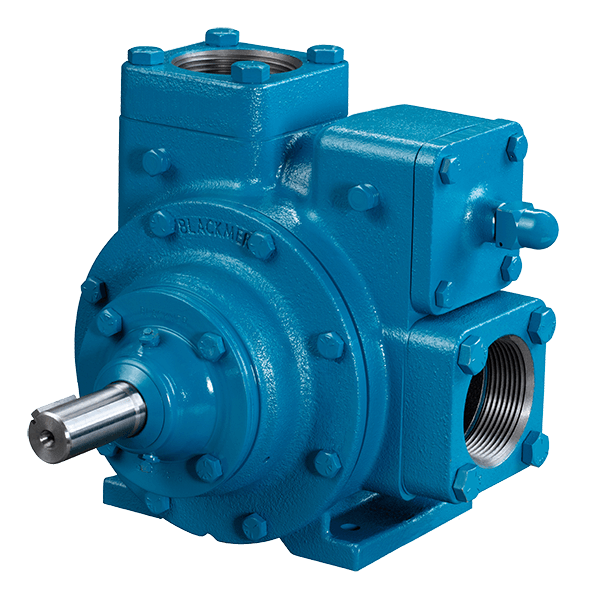
As a result, a wedge of oil is produced that is strong enough to support the whole weight of the bearings. The high oil pressure created by a gear, rotor, or vane pump is employed to provide a rapid enough flow of oil to absorb and take away heat from bearing surfaces and other elements of the engine that would otherwise overheat, such as the pistons.
Dual oil pumps are often seen in engines that employ a dry-sump system. One of these is used to produce lubricating oil pressure. The second pump (known as the ‘scavenge’ pump) transports oil from the sump to the oil tank. The second pump normally has a bigger capacity than the lubricating pump to avoid an excess of oil from collecting in the sump. Oil pumps do not require normal maintenance, albeit if they include a strainer, they should be cleaned regularly. When the sump is removed and sludge from the sump is removed, the work only has to be done once in a while.
Oil pumps are typically powered by adequate gearing from the camshaft or crankshaft. If the oil-pump outlet has been blocked and the pump has been subjected to excessive pressure, its gearing is likely to be destroyed. Oil pumps are supposed to have a nearly infinite operating life since they are continually submerged in oil. They do have a long operating life, but they do wear out eventually.
As a result, the oil pump output will eventually become insufficient to meet the engine’s needs. The wear between the components of the oil pump is usually specified in service manuals as a maximum limit. It is standard procedure to replace the oil pump as a whole if certain wear limitations are surpassed. This type of replacement is usually only done as part of a large engine overhaul or reconditioning.
The Double Gearwheel
The twin gearwheel kind of pump is rarely used in current automobiles, yet it is still used in the Audi 100. The concept of operation is similar to that of an eccentric rotor pump, with the exception that oil is circulated via voids produced between gear teeth rather than lobed rotors.
The two gearwheels are intertwined. One is powered by the camshaft, while the other, the idler wheel, rotates in the opposite direction. The pump body houses these gears, with just a little gap between the body and the gearwheels. The pump’s inlet and delivery ports are located on opposing sides. The gearwheels spin, creating a depression over the inlet port that draws oil into the pump. In the annular area between neighboring gear teeth, oil is thus moved around the pump.
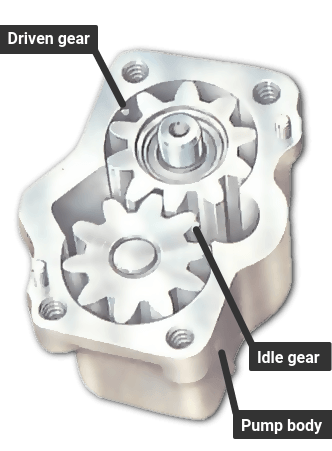
Oil is forced out of the tooth gaps into the delivery port and the lubricating system by the meshing of the gearwheels on the other side of the pump. To achieve equal wear of the gearwheels, certain gearwheel pumps have a driven gearwheel with one tooth fewer than the idler. Except for a tendency to leak at high pressures, this style of pump is simple and dependable. This may be avoided by installing the pump deep in the crankcase, where it is immersed in oil. However, it is 25% less efficient than the rotor pump and has so been extensively replaced.
Common Failure on Parts of Oil Pump
An oil pump failure can cause catastrophic damage to a car, especially if the driver is unaware of the failure indications. When a problem arises in the engine, the oil light indication on the dashboard turns on, alerting the driver that there is an issue. An oil pump’s failure symptoms are as follows:
- Low oil pressure: A malfunctioning or worn oil pump will not be able to pump oil through the system efficiently. The low oil pressure will ensue, potentially causing engine damage although as indicated earlier in this post, there are various indicators of low oil pressure.
- Increased engine working temperature: Because it minimizes friction, oil acts as a cooling agent in a vehicle’s engine. When the pump is in good working order, the engine will run at a normal temperature since the oil flow will be steady. When the engine oil flow slows or stops, however, the components continue to be lubricated by hot oil that is not permitted to flow.
- Noise: If a hydraulic lifter in a vehicle is not properly greased, it begins to create noise. These tend to be silent when the oil pump is in good working order and the oil is adequately circulated. Lifters are incredibly costly to replace, which is why the engine must never run dry.
This concludes the “parts of oil pump in internal combustion” article. We hope you have gained some information; if so, please leave a remark, share, and promote this site to other technical students. Thanks! Contact Linquip Pump Specialists if you have any inquiries regarding different types or parts of oil pump.
Buy Equipment or Ask for a Service
By using Linquip RFQ Service, you can expect to receive quotations from various suppliers across multiple industries and regions.
Click Here to Request a Quotation From Suppliers and Service Providers
Read More on Linquip
- Diaphragm Pump Parts List + Function & Application
- Parts of Water Pump
- Parts of Centrifugal Pumps
- 7 Parts of Gear Pump and Function + Diagram & Applications
- 10 Parts of Reciprocating Pumps + Function, Application and Working
- 10 Parts of Hydraulic Pump + PDF & Function
- 8 main Parts of Piston Pump and Function + Work & PDF
- 12 Parts of Sump Pump + Diagram
- 16 Parts of Heat Pump and Functions (Clear Guide)
- Centrifugal Pump Working Principle with Diagram
- 3 Types of Oil Pumps + Working Principle & PDF
- 13 Parts of Concrete Pump with Name & PDF
- 6 Parts of Pool Pump + Diagram & PDF
- 20 Parts of Submersible Pump + PDF
- 12 Parts of Sump Pump + Diagram
- 7 Parts of Screw Pump: Advantages and Disadvantages
- The 5 Best Air Source Heat pump in 2022 (Clear Guide)
- 7 Best RV Water Pump In 2022 (Clear Guide & Review)
- The 10 Best Electric Air Pump in 2022 (Clear Guide)
- The 8 Best Water Pumps of 2022 with Pros. and Cons

